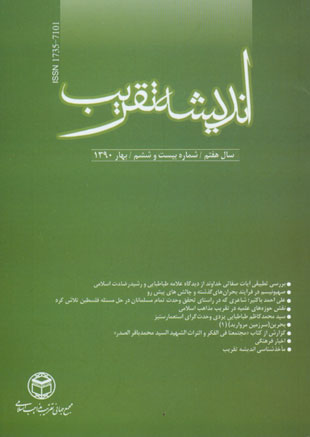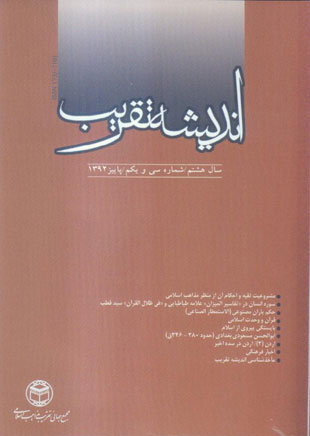فهرست مطالب

فصلنامه اندیشه تقریب
پیاپی 26 (بهار 1390)
- 196 صفحه،
- تاریخ انتشار: 1390/08/15
- تعداد عناوین: 12
-
صفحه 5
- مقالات اندیشه ای
- پیشگامان تقریب
- سرزمین های جهان اسلام
-
صفحه 107
- گزارشی از یک کتاب
-
صفحه 141
- ماخذشناسی اندیشه تقریب
-
صفحه 185
-
Page 11Quranic verses regarding divine attributes are a kind of Motashabeh verses describing divine attributes (which is a controversial topic) on the one hand and on the other hand, they are related to the Motashabeh verses which are too difficult to comprehend. This topic has created the groundworks for creation of different Islamic religions. As the nature of Islam is a religion of unity, this topic needs to be assessed. Hence, his paper compares and analyzes the viewpoints of two prominent Shiite and Sunni scholars,i.e. Alame Tabatabaee and Rashid Redha.There are two general methods concerning such Quranic verses: 1- Mothbatein (salaf): emphasizing on proving Khabari attributes which are available in these Quranic verses about God; 2- Mo’avalin (khalaf): emphasizing on God’s lack of such attributes After comparing Quranic verses concerning divine attributes in the two Quranic exegeses, it can be concluded that none of these authors believe in God’s physical body. Rashid Redha relies on the understanding of the majority of the followers of the Prophet and believes in Revayat’s authenticity and accepts the method of proving the acceptable (Esbat-e Maqbul) which is a type of Tafvidh. In Tafsir-e Al-Mizan- he follows Ahl-e Bayt (a.s) and considers the concept regardless of text format (method of ethbat-e Maqbul which is a Tasdiqi type). However, since these two authors have the same opinions in terms of principles and basics, we witness that they apply allegory and figurative meanings in entire verses in Al-Mizan and the majority of verses in Al-Menar.
-
Page 31Since the term ‘’Zionism’’ indicates to different heterogeneous political institutes. Finding a comprehensive definition for it is not easy. Usually, the word ‘’Zionism’’ comes with an adjective to limit the domain of its meaning; e.g. labor Zionism, Christian Zionism, cultural Zionism; however, the most famous classifications are political Zionism and religious Zionism. Religious Zionism is expressed mostly by Jewish mysticism and is related to the great desire and waiting for the master of Judaism. This Zionism developed the tradition of pilgrimage to the sacred land and even established a clerical center for dissemination of the Jewish beliefs and culture in the Zion land. The religious Zionism was never hostile with Muslims who were recognized with the children of Abraham and the followersof His religion. Religious Zionism is far from any type of political plan for establishing a state or any kind of domination of Palestine. They have never had any sign of movements against Arabs (be they Muslim or Christian).However, the political Zionism, which was formed by Theodor Hartselle, is skeptical of God and fights event against those Jews who define Judaism as a religion. From the viewpoint of political Zionism, the Jews are a clan before anything else, thus they cannot combine with other nations and they should settle in a free land where there is no proprietor. This concept indicates that the local people (Palestinians) are not important and they should not be given any attention. This issue has brought about several crises for the Zionists. What are these crises? The present paper attempts to assess the past crises and the future challenges of Zionism.
-
Page 55Ali Ahmed Bakthir (1949-2010) was born in Indonesia. He did primary studies in seminary school and learned Islamic studies and Arabic language. From early ages, he was interested in reading literature books. Bakthir went to Egypt to continue his education and learned English in Malik Fawaid School based in Cairo. After teaching for 14 years, he was transferred to national education ministry and started his job in high council of art and literature. Bakthir wrote several dramas and novels. He constantly emphasized upon Islamic unity in a way that this issue is apparent in his writings and poems. He was not fanatic in being a Sunni and this fact is a sign of his emphasis on Islamic unity. He has written and composed several poems and texts concerning Palestine and its occupation by the Zionists. He has described the issue of Palestine as a problem related to all Muslim nations and reproached the Arabs for their tolerance over this issue.
-
Page 65There are several barriers and challenges in the path of creating proximity between Islamic sects. Based on the theory of ‘’unity in the multiplicity’’ the challenges and threats can be removed or turned into opportunities. The Shiite seminary schools and the Sunni religious schools (due to their historical nature and academicreligious position) have the potential to play substantial role in proximity of Islamic sects and unity among Muslims and help remove their challenges. Seminary schools have two different applications regarding proximity, i.e. hard and soft. The present paper-in three sections- attempts to analyze various aspects of these two applications.
-
Syed Muhammad kadhim Tabatabaee Yazdi A man who had a unity approach and fought against colonizationPage 91The true scholars are the supporters of knowledge and practice. Some of the scholars reach such an academic and spiritual excellence that they become pioneer and role-model for everyone. One of these scholars who had a unity approach and constantly fought againstcolonizers of 20th century and moved all the Muslims against tyranny and Islam’s enemies with his Jihad decree is Ayatollah Syed Mohammad Kadhim Tabatabaee Yazdi, the author of Orvat Al- Vothqa. This paper is a brief introduction of this great scholar. The paper includes the following sections: his birth and family; introductory education, academic position and teachings, academic works, sociopolitical issues during his time, Syed and the imposed constitution (mashrot-e), his wisdom and policies against colonizers’ conspiracies, announcing Jihad against Briton and other colonizers, his approach towards unity and supporting Iran and Ottoman State and his activities for promoting unity through sending letters and telegraphs and other means.
-
Page 107The small country of Bahrain has an old history. The topics covered in this paper include: geographical location, area and its boarders, its common name and its other historical names, natural geography, cities and ports and major islands, historical backgrounds of population formation, tribes and ethnic groups and their relations, language, script and the country’s history when the nation converted to Islam. Another part of the paper is allocated to Bahrain’s strategic location and colonizers’ entry to Bahrain particularly the UK and U.S. and occupation of Bahrain by them and establishing military base in the country. And the other section is about Bahrain as the location of struggle and movement.


